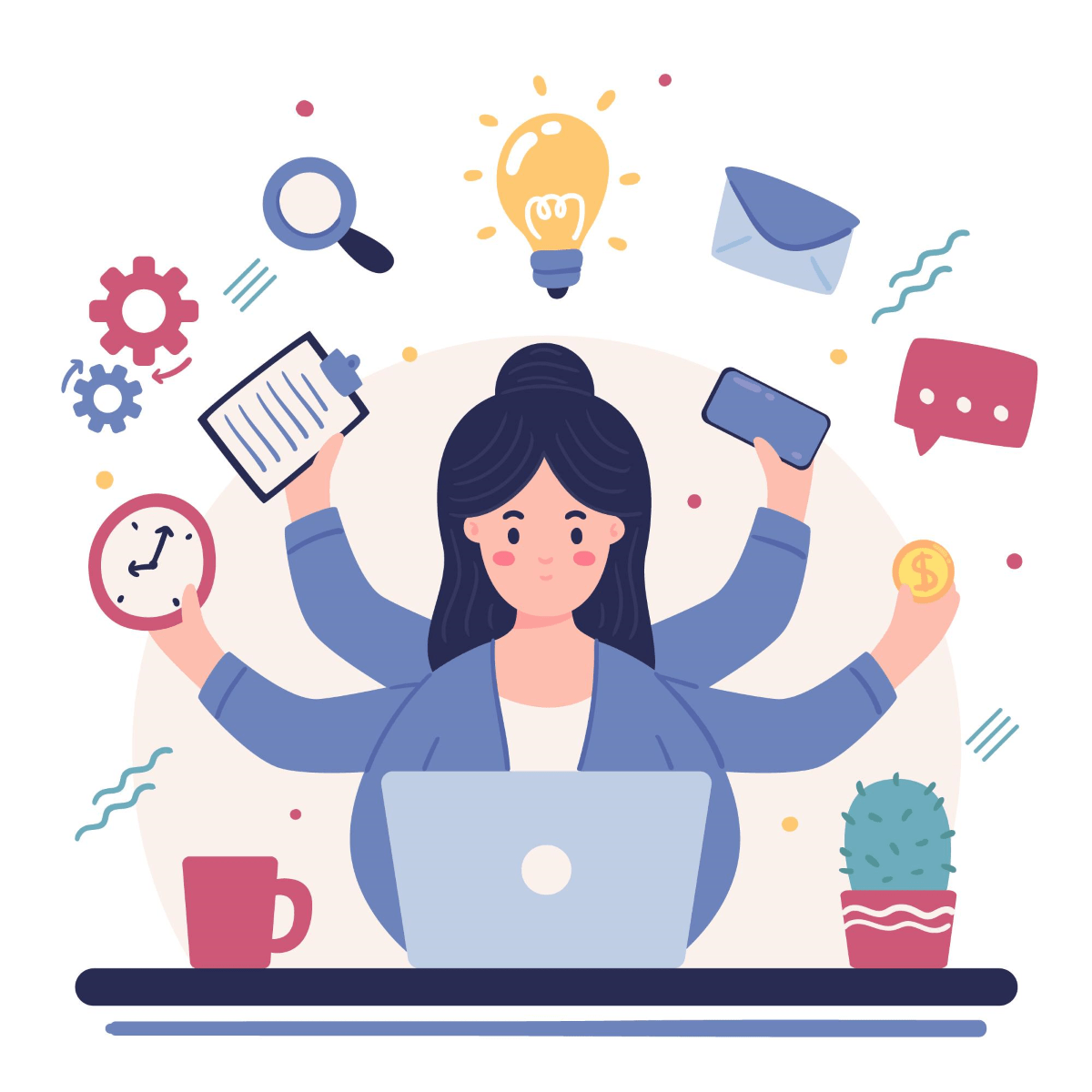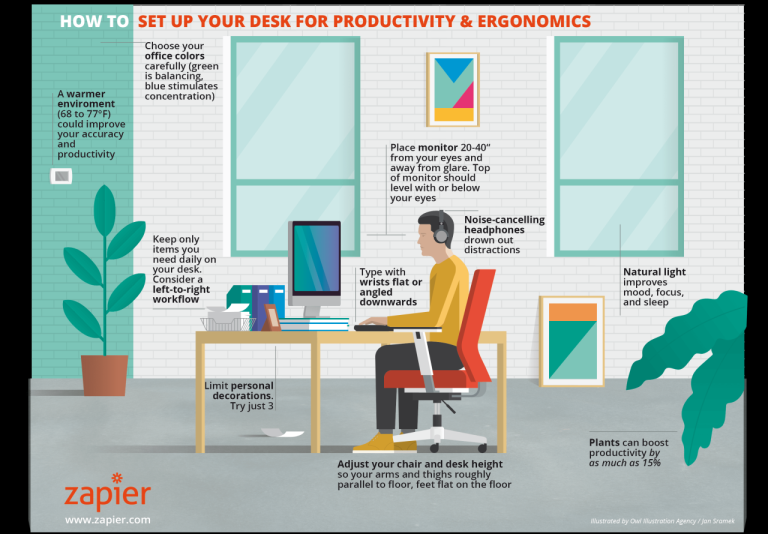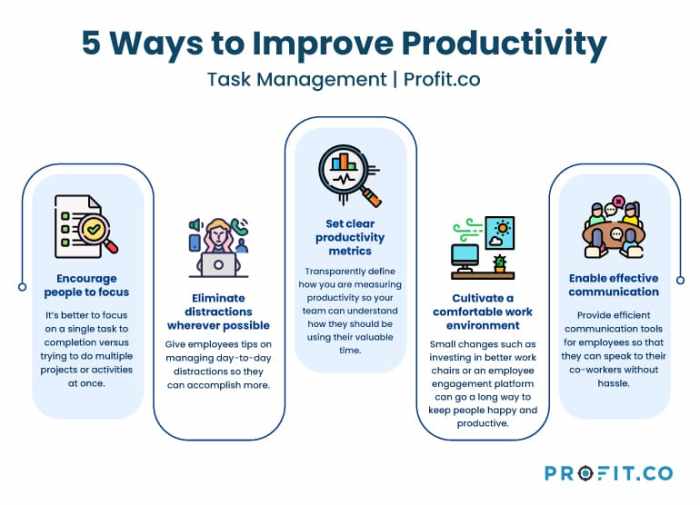
In today’s fast-paced work environment, multitasking is often perceived as a necessity. However, the reality is more nuanced. While the ability to juggle multiple tasks might seem efficient, it can actually hinder productivity and lead to stress. This article explores the complexities of multitasking and provides practical strategies for navigating the challenges, ultimately helping you work smarter, not harder.
We’ll delve into the science behind multitasking, uncovering the hidden costs of task switching and its impact on focus. Then, we’ll equip you with a toolkit of effective strategies for managing your workload, including time management techniques, workflow optimization, and technology utilization. We’ll also address the importance of setting boundaries and managing distractions to maintain focus and avoid burnout.
Understanding Multitasking and Its Impact on Productivity
Multitasking is a common practice in today’s fast-paced work environment, but it’s often misunderstood. Many believe that juggling multiple tasks simultaneously increases efficiency, but research shows the opposite is true. Multitasking can actually hinder productivity and lead to errors.
The Myth of Multitasking
The idea that we can effectively handle multiple tasks at once is a misconception. Our brains are not wired to perform multiple complex tasks simultaneously. When we try to multitask, we are actually switching our attention rapidly between tasks, a process known as task switching.
Task Switching and Its Cognitive Cost
Each time we switch tasks, our brain needs to re-orient itself, which takes time and effort. This constant shifting of attention can lead to:
- Reduced focus and concentration on any one task
- Increased errors and mistakes
- Slower completion times
- Increased stress and frustration
The cognitive cost of task switching can be significant, especially for complex tasks that require deep thinking and problem-solving.
The Benefits and Drawbacks of Multitasking
While multitasking may seem like a way to get more done, it’s important to consider both its benefits and drawbacks:
Benefits:
- Time Management: Multitasking can help you manage your time more effectively by allowing you to work on multiple tasks simultaneously, especially for simple tasks like answering emails and scheduling appointments.
- Flexibility: It can help you adapt to changing priorities and demands in a dynamic work environment.
- Efficiency: Multitasking can be beneficial for tasks that are simple, repetitive, or require minimal cognitive effort.
Drawbacks:
- Reduced Focus and Concentration: As mentioned earlier, multitasking can lead to decreased focus and concentration, resulting in lower quality work.
- Increased Errors and Mistakes: The constant switching of attention can increase the likelihood of errors and mistakes, which can lead to rework and delays.
- Slower Completion Times: Although multitasking may feel like it saves time, research shows that it often leads to slower completion times for tasks, as the brain is constantly shifting between tasks.
- Increased Stress and Frustration: The constant switching of attention and the pressure to complete multiple tasks simultaneously can lead to increased stress and frustration.
Strategies for Effective Multitasking

Multitasking can be a double-edged sword. While it can seem like a way to get more done in less time, it often leads to decreased productivity and increased stress. The key to successful multitasking lies in understanding your tasks, prioritizing them effectively, and implementing strategies that optimize your focus.
Prioritizing Tasks
Prioritizing tasks is crucial for effective multitasking. Different tasks demand different levels of attention and effort. Categorizing tasks based on their urgency and importance can help you allocate your time and energy wisely.
- Urgent and Important: These tasks require immediate attention and have significant consequences if not completed promptly. Examples include meeting deadlines, addressing critical issues, and responding to urgent client requests. These tasks should be tackled first.
- Important but Not Urgent: These tasks are essential for long-term goals and require careful planning and execution. Examples include strategic planning, project development, and professional development activities. These tasks can be scheduled for later, but they should be planned and tracked to avoid procrastination.
- Urgent but Not Important: These tasks demand immediate attention but have minimal impact on your overall goals. Examples include responding to non-critical emails, attending unnecessary meetings, and handling minor administrative tasks. These tasks can be delegated or postponed if possible.
- Not Urgent and Not Important: These tasks have minimal impact on your work and can be safely ignored or delegated. Examples include social media browsing, personal errands, and non-essential tasks. These tasks should be avoided during work hours.
Designing a Workflow for Effective Multitasking
A well-designed workflow is essential for minimizing task switching and maximizing focus. Here are some strategies to consider:
- Batch Similar Tasks: Grouping similar tasks together allows you to maintain focus and momentum. For example, instead of constantly switching between writing emails, reviewing documents, and attending meetings, schedule dedicated blocks of time for each activity.
- Use Time Blocking: Allocate specific time slots for different tasks. This helps you stay organized, prioritize your workload, and avoid distractions. For example, you can block out 2 hours for focused work on a critical project, followed by 1 hour for responding to emails.
- Minimize Interruptions: Identify and eliminate potential distractions. Turn off notifications, close unnecessary tabs, and inform colleagues that you are unavailable during focused work sessions.
Time Management Techniques for Multitasking
Time management techniques can help you optimize your time and improve your multitasking efficiency.
- Pomodoro Technique: This technique involves working in focused intervals, typically 25 minutes, separated by short breaks. This method promotes concentration and helps to avoid burnout.
- Timeboxing: This technique involves pre-planning your day by allocating specific time blocks for different tasks. This helps you stay organized, prioritize your workload, and avoid procrastination.
Tools and Techniques for Enhanced Multitasking
Harnessing the power of technology and adopting effective strategies can significantly enhance your multitasking abilities. By utilizing the right tools and techniques, you can streamline your workflow, optimize your time, and improve overall productivity.
Productivity Apps and Software
Productivity apps and software are designed to help you organize your tasks, manage your time, and stay focused. They provide a range of features that can assist you in effectively handling multiple projects and responsibilities.
- Task Management Apps: These apps help you create to-do lists, prioritize tasks, set deadlines, and track progress. Examples include Asana, Trello, and Todoist. These platforms allow you to collaborate with colleagues, assign tasks, and monitor project timelines.
- Time Management Tools: Time management tools like Toggl Track and Clockify help you monitor how much time you spend on different tasks. This data can provide valuable insights into your work habits and help you identify areas where you can improve your efficiency.
- Focus and Concentration Apps: Focus and concentration apps, such as Freedom and Forest, block distracting websites and apps for a set period, enabling you to maintain focus on your work. These apps can be particularly helpful when multitasking, as they create a distraction-free environment.
Leveraging Technology for Communication and Collaboration
Technology plays a crucial role in facilitating effective communication and collaboration while multitasking.
- Instant Messaging and Video Conferencing: Instant messaging platforms like Slack and Microsoft Teams enable real-time communication with colleagues, facilitating quick questions, updates, and discussions. Video conferencing tools like Zoom and Google Meet allow for face-to-face interactions, enhancing collaboration and fostering a sense of connection even when working remotely.
- Cloud-Based Collaboration Tools: Cloud-based collaboration tools like Google Docs and Microsoft Office 365 allow multiple users to work on documents simultaneously, enabling seamless collaboration and real-time updates. This eliminates the need for email chains and ensures everyone is working on the latest version of the document.
Setting Boundaries and Managing Distractions
Setting clear boundaries and managing distractions are essential for maintaining focus and productivity while multitasking.
- Dedicated Work Space: Establishing a dedicated workspace, free from distractions, can significantly improve your ability to concentrate. This could be a separate room, a designated desk, or even a specific chair in your home.
- Time Blocking: Time blocking involves scheduling specific time slots for different tasks, allowing you to allocate dedicated time for each activity. This helps you stay organized, avoid multitasking overload, and ensure that you are making progress on each task.
- Prioritizing and Delegating: Prioritize your tasks based on their importance and urgency. Delegate tasks that can be handled by others, freeing up your time and mental energy for more complex activities.
Productivity in a Multitasking World
Multitasking, while seemingly efficient, can lead to a decline in productivity if not managed effectively. Maintaining focus and achieving optimal output requires a mindful approach to juggling multiple tasks.
Maintaining Focus and Productivity
Regular breaks and mindfulness practices are crucial for maintaining productivity in a multitasking environment. Short breaks throughout the day allow the brain to rest and recharge, preventing burnout and improving focus. Mindfulness techniques, such as meditation or deep breathing exercises, can help to quiet the mind and enhance concentration.
Adapting to Changing Priorities and Interruptions
Multitasking often involves dealing with unexpected interruptions and changing priorities. It’s essential to have a system in place to adapt to these situations. Prioritize tasks based on urgency and importance, and be prepared to adjust your schedule as needed. Communicate with colleagues and clients about your availability to minimize disruptions and ensure smooth workflow.
Strategies for Handling Common Multitasking Scenarios
Here are some common multitasking scenarios and effective strategies for handling them:
| Scenario | Strategy |
|---|---|
| Receiving a urgent email while working on a presentation | Acknowledge the email, set a reminder to address it later, and return to the presentation. |
| Being interrupted by a colleague with a question | Briefly address the question, schedule a follow-up if necessary, and return to your original task. |
| Having multiple deadlines approaching simultaneously | Create a timeline, prioritize tasks based on urgency and importance, and delegate tasks if possible. |
| Responding to phone calls while writing a report | Use a call-screening service or voicemail to manage calls, or set aside dedicated time for phone calls. |
Beyond Multitasking: The Power of Focus

While multitasking may seem like a productivity booster, research suggests that it often leads to decreased efficiency and increased errors. Switching between tasks constantly fragments our attention, making it harder to fully engage with any one task. This leads to a decline in the quality of work and overall productivity. Focusing on single tasks, on the other hand, allows us to dedicate our full mental energy, resulting in better quality work and a sense of accomplishment.
The Benefits of Single-Tasking
Dedicating focused blocks of time to specific tasks can significantly improve our work output and quality. This approach, known as single-tasking, allows us to:
- Improve Focus and Concentration: By eliminating distractions and committing to a single task, we can achieve a state of deep focus, leading to greater concentration and improved performance.
- Enhance Quality of Work: Single-tasking allows us to delve deeper into the task at hand, leading to more thoughtful and thorough work. This results in fewer errors and a higher quality output.
- Boost Productivity: While multitasking may seem like a time-saver, studies show that it can actually reduce productivity. Single-tasking allows us to complete tasks more efficiently, leading to a higher overall output in the long run.
- Reduce Stress and Anxiety: Constantly switching between tasks can be mentally taxing, leading to stress and anxiety. Single-tasking allows us to focus on one task at a time, reducing mental overload and promoting a more relaxed work environment.
Cultivating a Focus Mindset
Transitioning from a multitasking mindset to a focus-oriented approach requires conscious effort. Here are some strategies to cultivate a mindset that prioritizes deep work:
- Identify Your Peak Productivity Times: We all have times of the day when we are more alert and focused. Identify these peak periods and schedule your most demanding tasks during these times.
- Minimize Distractions: Create a distraction-free work environment. This could involve turning off notifications, using noise-canceling headphones, or working in a quiet space.
- Break Down Tasks into Smaller Chunks: Large, overwhelming tasks can be daunting. Break them down into smaller, manageable chunks, making them less intimidating and easier to focus on.
- Embrace the Pomodoro Technique: This time management technique involves working in 25-minute intervals, followed by a short break. This approach helps maintain focus and prevent mental fatigue.
- Practice Mindfulness: Mindfulness exercises can help train your mind to focus on the present moment, reducing distractions and improving your ability to concentrate.
Ultimately, achieving true productivity in a multitasking world requires a shift in mindset. While embracing multitasking may seem inevitable, prioritizing focus and single-tasking can yield remarkable results. By dedicating focused blocks of time to specific tasks and cultivating a mindset that values deep work, you can unlock your true potential and achieve peak productivity. This article has provided you with a framework for navigating the complexities of multitasking and achieving a balance between efficiency and effectiveness.
Remember, it’s not about doing everything at once, but rather, doing the right things at the right time, with focus and intention.
FAQ Resource
What are some common misconceptions about multitasking?
Many people believe multitasking makes them more efficient, but research shows that it actually reduces productivity and increases errors. Our brains are not designed to effectively handle multiple tasks simultaneously.
How can I prioritize tasks effectively when multitasking?
Use a system like the Eisenhower Matrix to categorize tasks based on urgency and importance. Focus on urgent and important tasks first, and delegate or postpone less important tasks.
What are some tools that can help me manage my time and tasks while multitasking?
Popular tools include task management apps like Trello, Asana, and Todoist. These platforms allow you to organize tasks, set deadlines, and track progress.
How do I avoid distractions when multitasking?
Create a dedicated workspace free from distractions, use noise-canceling headphones, and set clear boundaries with colleagues and family members.



